This post may contain affiliate links. Please see my disclosure policy for details.
One of the highlights of my recent visit to Andalusia was the majestic Cordoba Mosque-Cathedral or Cordoba Mezquita.
Spanning 1000 years of history, it’s had a turbulent past being a temple for Romans, Visigoths, Moors and Christians.
Today, it’s a riot of religion and architectural styles that will blow you away. You’ll find Moorish, Mudejar and Renaissance elements spanning the centuries.
It’s truly a remarkable place and well worth seeing in Spain. There are even ways to visit for free before the larger crowds roll in.
Here is how to visit Cordoba Cathedral for free and all the highlights you shouldn’t miss!

Cordoba Mosque-Cathedral history
This temple has many names due to its history as a Moorish mosque and Christian Cathedral.
It’s known as the Great Mosque of Cordoba (Gran-Mezquita) due to its Caliphate history and is one of the largest Islamic buildings in Western Europe.
It’s also called Cordoba Cathedral or Cathedral of Our Lady of the Assumption after the Christian conquest.
Most people simply call it Cordoba Mosque-Cathedral as there are heavy elements in both periods having been preserved inside.
But, the history of this temple stretches even further to the Roman period under Emperor Claudius.
Cordoba was a Roman settlement and walled city in the 1st century and they built the Roman Bridge over the Guadalquivir river that is still here today.
According to archaeological digs, a Roman temple was built on the site of the Cordoba Mezquita dedicated to Janus, the god of doors, gates and transitions.
Later, it became a Visigothic Basilica for San Vicente in the 6th century. It was only discovered during excavations centuries later but can be found underneath the site.

Aljama Mosque
During the Moorish occupation, Abd al-Rahman I from the Umayyad dynasty decided to build a mosque after his conquest of Cordoba in 756.
He later declared Cordoba an independent Emirate and became the first Emir of al-Andalus.

Worship was previously taking place in the old Visigothic Basilica and there was a demand for a Muslim temple. So, he founded the Aljama Mosque as a symbol of grace and power.
His son and later successors expanded the mosque, building a minaret tower, libraries, a Mihrab, ceramic domes and skylights.


Reconquista & Cordoba Cathedral
During the events of the centuries-long Reconquista, Moorish rulers were eventually forced to flee Cordoba.
In 1246, King Ferdinand III of Castile conquered the city and it became a consecrated cathedral. It has remained so ever since.
Thankfully, most of the Moorish architecture from the Aljama Mosque has been preserved along with the Christian expansions.


The result is a truly unique place of worship in Spain and an important monument that embodies the story of Andalusia.
It was officially declared a UNESCO World Heritage Site in 1984 and this status was expanded to the historic centre of Cordoba in 1994.
Today, it’s one of the most popular attractions in Spain seeing almost 2 million visitors each year!

Can you visit Cordoba Mosque-Cathedral for free?
Yes, there is a way to visit Cordoba Mosque-Cathedral for free if you visit in the early morning.
The mosque allows free entry from 8.30 am on Mondays to Saturdays and this is a great time to go as it’s a calmer experience.
In the morning the temple is almost empty as no tour groups are allowed inside at this time. It’s the perfect time to visit for photography.
You’ll get around 50 minutes to explore Cordoba Mezquita before they start ushering people out for mass that begins at 9.30 am.
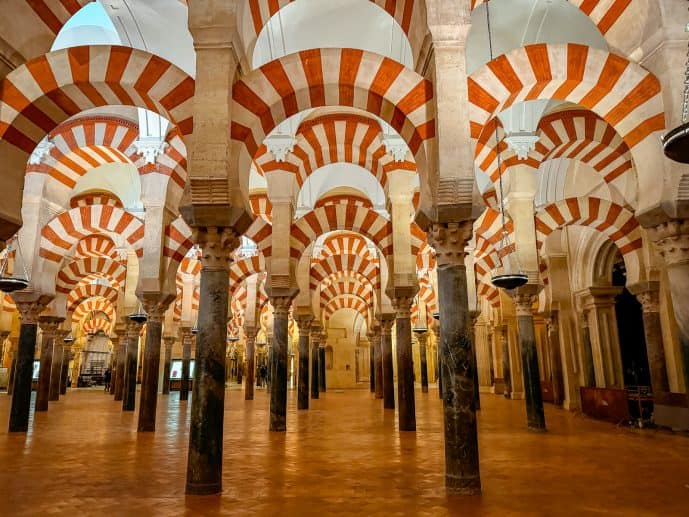
If you feel like your time has been too short, I’d recommend staying for the mass service. After, all the attendees are allowed to stay in the cathedral for as long as they like.
So, set that alarm for early morning as it was an experience well worth getting up for!
I travelled from Seville for this opening time and I thought it was worth it but I’d recommend staying overnight in Cordoba if you value sleep.
Although you can enter the complex free of charge, donations are always appreciated for the upkeep and conservation.


Cordoba Mezquita highlights
Due to its fascinating history, there are many highlights of the Cordoba Mosque-Cathedral.
You’ll find Visigothic remains, an Islamic Hypostyle Hall and Mihrab as well as Catholic chapels and choir stalls. There are even ancient Roman artefacts from the 1st century AD.
This temple is a riot of history and religion with something amazing to find around every corner! Don’t miss these highlights on your visit;


1. The Prayer Hall & Column Arches
The most impressive part of the mosque is the enormous Prayer Hall that has hundreds of columns and red and white striped double arches.
This was a basilica model and was heavily inspired by the mosques of Damascus and al-Aqsa in Jerusalem.
The original hall was built by Abd al-Rahman I. It was then expanded by his successors so you’ll notice that some columns are older than others.
It was historically lit by hanging sconces and candle light but these are all electric today.
The archways were mesmerising to behold and seemed to be endless like an optical illusion. They make great photo opportunities too.
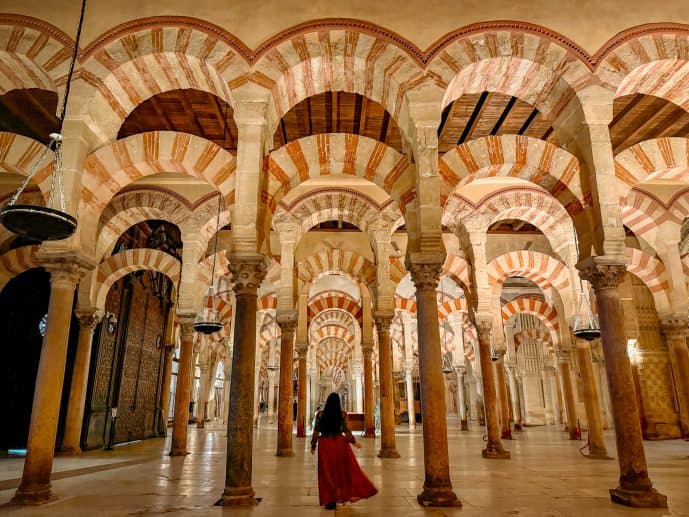
2. The Mihrab, Maqsurah & Ceramic Dome
It was Al-Hakam II who ordered some of the most impressive features of the mosque to be constructed like the Maqsurah and Mihrab lit by impressive domes and skylights.
Al-Hakam even wrote to the Byzantine Emperor of Constantinople requesting the help of a mosaicist for the work. The emperor agreed and sent 1.6 kg of mosaics with a master craftsman as a gift!
A Mihrab is a niche that indicates the direction of Mecca and the elaborate Maqsurah was used for Al-Hakam’s private prayer. As a ruler, this was made for his protection.
The exquisite details and Arabic scripture in these parts of the mosque are outstanding and adorned with interlacing archways.
If you look above the central doorway, you’ll find an ornate ceramic dome and skylight. The detail in the mosaic work was utterly breathtaking!


3. Cathedral
After the Caliphate era collapsed, Ferdinand III captured the city and was consecrated for Christian worship.
Instead of completely rebuilding the temple, they expanded on what was left and constructed the original Villaviciosa Chapel under the skylight of Al-Hakam II.
A Royal Chapel was then constructed under King Alfonso X and several other chapels have been built over the years in the Renaissance period.
The main altar, transept and choir were built in 1523 by Hernán Ruiz I where mass and services are still held today.


4. Chapels
There are so many chapels in this cathedral you could spend an entire day admiring them all.
Of course, you have the Main Chapel and the altar of the cathedral with a transept and choir along with the original Villaviciosa Chapel. But, you’ll also find;
- Chapel of the Conversion of Saint Paul
- Chapel of San Esteban
- Chapel of the Nativity of Our Lady
- Chapel of the Souls of Purgatory
- Chapel of Our Lady of Conception
- Chapel of Santa Teresa
- Chapel of Santa Inés
Some of the larger ones are open to explore but many are closed off and you can only see them through the gates.
Plus, there are several smaller chapels dotted around with stunning portraits, triptychs and artefacts.


5. Parroquia del Sagrario
One of the most impressive rooms in the cathedral is the Parroquia del Sagrario which has many functions.
It is used as the Chapel of Santiago, the Chapter Library and a sanctuary that has been used since the 16th century.
I could not get over how beautiful all the colourful ornate frescoes that were in this room with the vaulted ceiling and the central portrait of the Holy Supper.

6. Museum rooms
As well as being a unique and active place of worship, there are several museum exhibits around the mosque-cathedral.
Cordoba was a settlement in Roman times under Emperor Claudius and archaeological discoveries have revealed lots of artefacts left over from this time.
Before a mosque was even built there is evidence that this site was a Roman temple that was devoted to Janus, the god of doors, gates and transitions.
So, you’ll find lots of Roman columns, pottery, mosaics and weapons. Also, there are sections from the Caliphate era with Arabic calligraphy and Christian artefacts like robes, croziers and chalices.


7. Bell Tower
Towering over the Cordoba Cathedral is the bell tower that is 54 metres high and so this makes it the tallest building in the city.
Before the Christian conquest, this used to be the minaret of the Aljama mosque.
In 1589, the tower was destroyed in an earthquake and so a new bell tower was created. It is still part of the daily life of the cathedral today.
You can climb up the bell tower to get amazing panoramic views over the cathedral and city with attractions like the Roman Bridge and Alcazar of the Christian Monarchs.
Tower tickets cost an extra €3 and you can buy these online as part of your ticket purchase.
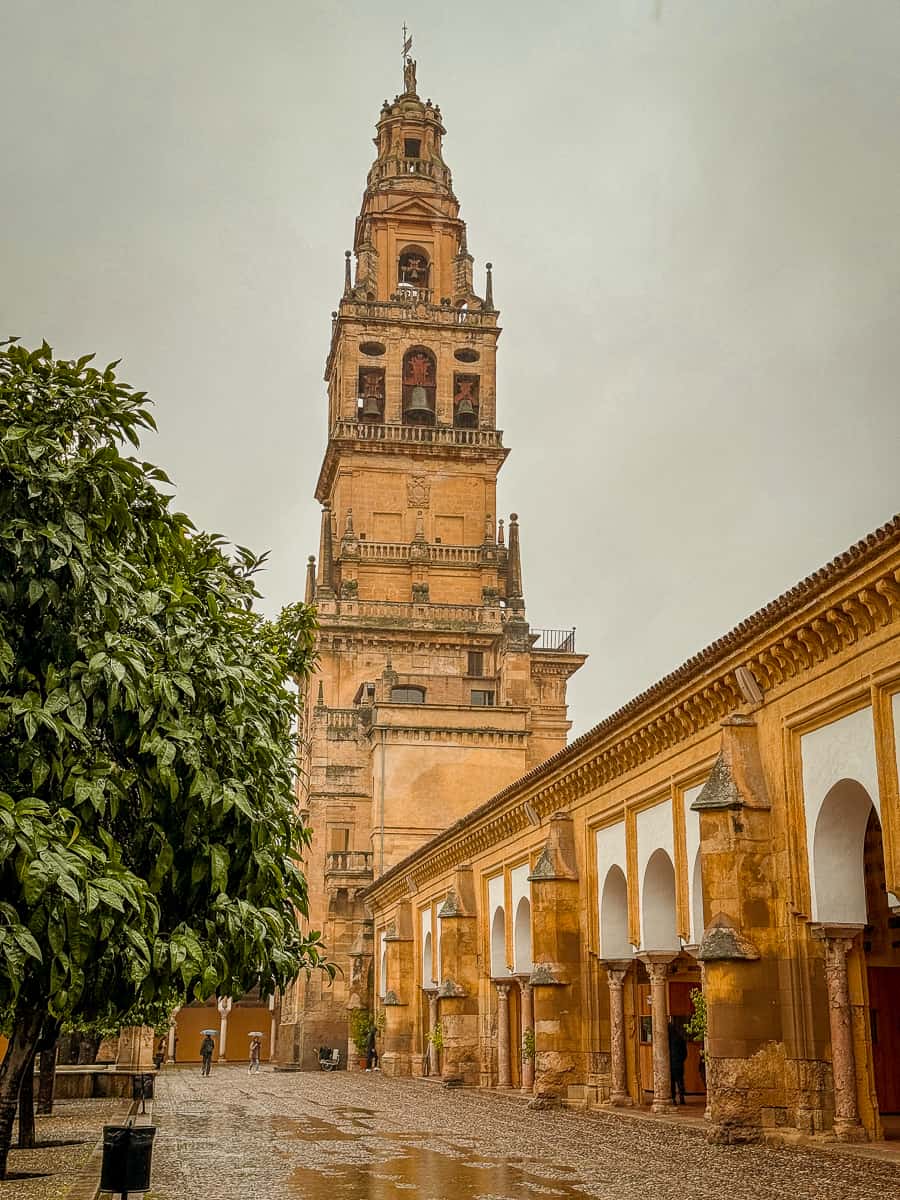
8. Patio de las Naranjos
In the central courtyard of the cathedral, you’ll find the Patio de las Naranjos (Orange Patio) with an orchard of orange trees.
During the mosque years, this used to be the Caliphate courtyard (sahn) of ablutions. This is the ritual of cleansing and purification before Muslim prayer.
After, when it became a cathedral, it was transformed into an enclosed cloister and a garden was installed by Bishop Francisco Reinoso in the 16th century.
Today, there are orange trees, palm trees and cypresses as well as ornamental fountains to admire.
Unfortunately, it was pouring down on my visit but I admired it from the cloister in the dry.

9. Celebration of the Eucharist in the Choir
If you do happen to visit the Cordoba Mosque-Cathedral for free, they will start ushering people out around 9.20 am.
This is so that the daily mass or the Celebration of the Eucharist can take place at 9.30 am in the Choir Stalls.
I realised that I had never attended a mass before, so I decided to stay and it was a beautiful experience.
I didn’t understand much as it was in Spanish but they have an organ that is played during the service with singing. Due to the high vaulted ceilings, the acoustics here were excellent.
Many people will line up to receive their Transubstantiation or Communion of ‘wine and bread’ that represents the blood and body of Jesus Christ but you’re not obligated to do this.
I didn’t as I’m an atheist and I wasn’t too keen to drink from the same goblet as everyone else after recent events.
However, everyone was expected to kneel and it was quite uncomfortable on the cold hard floor. My knees were cracking and I felt so old.
Photography is strictly prohibited and you can’t explore the cathedral when the service is taking place.
But, after the mass you’re free to stay so I got to explore even longer than I expected. 50 minutes felt far too short for this incredible monument.

10. Cordoba Cathedral at night – “The Soul of Cordoba”
Did you know that you can visit Cordoba Cathedral at night?
They run special evening tours called “The Soul of Cordoba” where you can see the Mezquita in an entirely different light.
Tickets cost €20 which is more than the normal entry fee but it would be a unique and special way to experience this incredible temple.
Even during the day, this place is very dark so I can’t imagine what it’s like in the evening.

How to visit Cordoba Mosque-Cathedral
The Mosque-Cathedral of Cordoba is the beating heart of this Andalusian city that all roads seem to lead to and you can find it close to the famous Roman Bridge in Cordoba Old Town.
You really won’t miss it as it’s Cordoba’s main attraction and there are signs all over the city to guide you.
Cordoba makes a great day trip from Seville as it only takes around 45 minutes to get there by train. It’s the same train service heading to Granada.
You can book tickets easily on the Renfe website or use Trainline. Make sure to book tickets in advance as certain journeys can sell out!
From the station, it’s a 25-30 minute walk to the Cordoba Cathedral or the number 5 bus will take you there in 20 minutes as well.
But, you can easily take a taxi or Uber there to save some time if you’re visiting early for opening time! This is what I did as our train was running a little late.
Alternatively – why not book this Cordoba day trip that will guide you around the city?
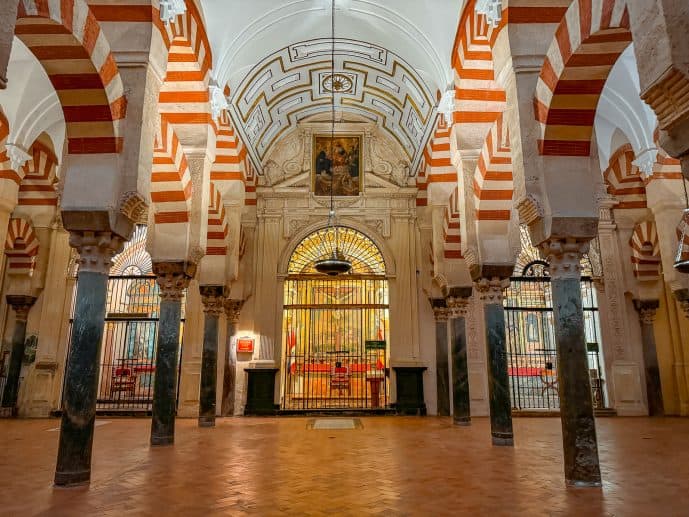
Opening hours & normal entry fees
From Monday – Saturday the Mosque-Cathedral of Cordoba opens at 8.30 am – 9.20 (ish) with free entry. The only exceptions are when there are important religious days like Good Friday.
A mass takes place from 9.30 am – 10 am with no photography allowed. It’s then open to the public from 10 am – 7 pm at night. The last entry is 30 minutes before closing.
On Sundays, it’s open from 8.30 am – 11.30 am (not free) and then there’s a break for worship and it opens again from 3 pm – 7 pm. The last entry is 30 minutes before closing.
On certain evenings, they run special guided tours “The Soul of Cordoba” where they are open until late. It varies with the seasons but sometimes it’s open as late as 11.30 pm!
If you don’t want to visit Cordoba Cathedral early morning for free entry, normal entry fees are €13 for an adult and €7 for children (10-14).
Under 10-year-olds get in free of charge. There are concessions for students, seniors and disabled visitors.
It’s recommended to book tickets in advance and online. Only book via the official website as there are lots of third-party ticket companies that charge huge premiums.

My top tips for visiting
Go early – I would go early for the free opening time if you can around 8.30 am! It’s a great time to go before it gets too busy with mass tour groups.
Wear modest clothing – you don’t have to cover your head but shorts / short dresses are not usually permitted as it’s an active place of worship.
Tripods are not allowed – You can’t use tripods or selfie sticks inside. This is a shame as it’s such low lighting but what can you do?
Consider later in the afternoon – after the general admission, it can get really busy in the mornings. Later in the afternoon around closing time is more peaceful.

Things to do in Cordoba after your visit
I visited Cordoba on a day of unexpected torrential rain where the streets were flooding and lots of attractions closed for safety. So, I didn’t get to see as much of the city as I would have liked to.
I got absolutely soaked through and my bag with all my things ended up drenched. So, I ended up heading back to Seville as many trains were getting cancelled due to the freak storm. I guess it gives me a reason to back!
After I visited Cordoba Cathedral, I headed over to Flower Courtyard (Calleja de las Flores) to see the iconic view of the Bell Tower through the colourful alleyway.
Cordoba is known for its Courtyards Festival which is a UNESCO World Heritage event. So, there are plenty of gorgeous ones to see like Patios Cordobeses.
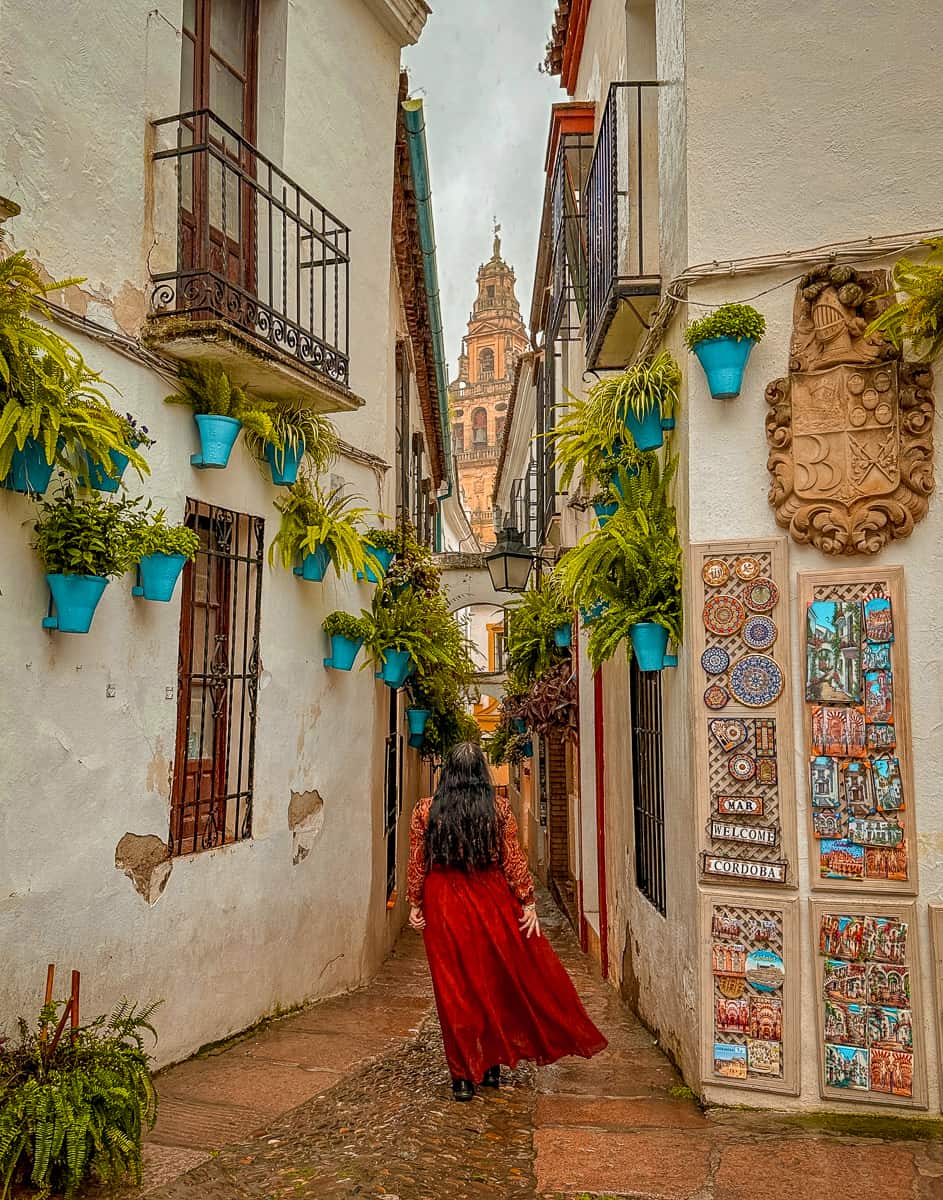
Then I popped over to the famous Roman Bridge originally constructed in the 1st century. You can climb up Torre De Calahorra at the end for panoramic views over the Guadalquivir River.
Near the bridge, you can visit the Alcazar of the Christian Monarchs. This was built in the 14th century in the Mudejar style after the Reconquista.
Plaza de la Corredera is the main square of the city and you can visit the Roman Temple and Palacio de Viana from here. Also, the Baroque Palacio de la Merced looks gorgeous.
There’s so much to see and do here, you may want to spend 2 days in Cordoba to see everything at a relaxed pace.
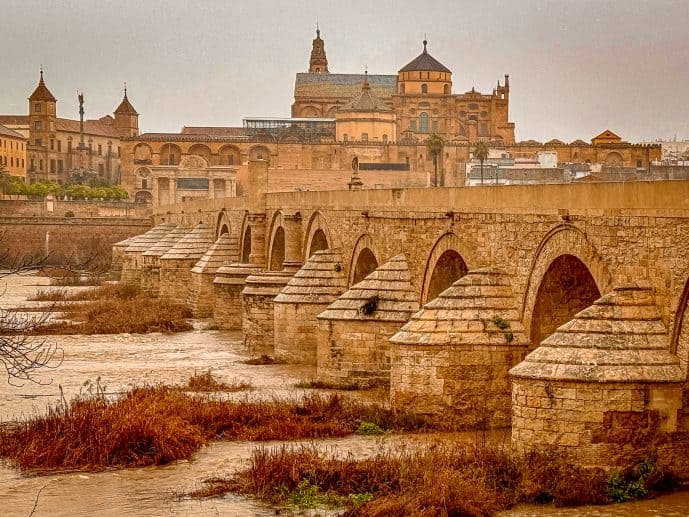
Read more of Spain travel guides
Plaza de España Seville – Visit Naboo from Star Wars
Why you shouldn’t skip Casa de Pilatos in Seville
Mirador San Nicholas viewpoint in Granada
Casa Battló – Gaudi’s Dragon House of Bones
30+ Instagrammable places in Barcelona
14+ Things to do in Park Güell
How to visit Bunkers del Carmel in Barcelona
The gorgeous Cascada Monumental
Discover Sant Pau Recinte Modernista
Secrets of Pont Del Bisbe Bridge
How to visit the Kiss Wall Barcelona
Why you must visit the Fairy Bar in Barcelona
You must visit Palau de la Musica Catalana
Save how to visit Cordoba Mosque-Cathedral for FREE!

